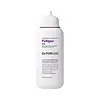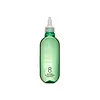What's inside
What's inside
 Key Ingredients
Key Ingredients

No key ingredients
 Benefits
Benefits

 Concerns
Concerns

 Ingredients Side-by-side
Ingredients Side-by-side

Water
Skin ConditioningCocamidopropyl Betaine
CleansingSodium Lauroyl Methylaminopropionate
CleansingSodium Cocoyl Alaninate
Disodium Laureth Sulfosuccinate
CleansingLauryl Glucoside
CleansingCocamide Mea
EmulsifyingSodium Chloride
MaskingPolyquaternium-10
Sodium Benzoate
MaskingPEG-150 Distearate
EmulsifyingPPG-3 Myristyl Ether
EmollientCaprylyl Glycol
EmollientCitric Acid
BufferingPanthenol
Skin ConditioningSalicylic Acid
MaskingNiacinamide
SmoothingMenthol
MaskingHydrolyzed Conchiolin Protein
Skin ConditioningHydrolyzed Keratin
HumectantHydrolyzed Silk
HumectantHydrolyzed Collagen
EmollientDipropylene Glycol
HumectantPentasodium Pentetate
Acacia Senegal Gum
MaskingButylene Glycol
HumectantGlycerin
Humectant1,2-Hexanediol
Skin ConditioningPeat Water
Skin ConditioningHydroxypropyl Methylcellulose
Emulsion StabilisingCaprylic/Capric Triglyceride
MaskingLavandula Angustifolia Extract
Skin ConditioningRosmarinus Officinalis Leaf Extract
AntimicrobialChamomilla Recutita Extract
Skin ConditioningMentha Citrata Leaf Extract
AstringentPrunus Salicina Fruit Extract
AntioxidantMentha Piperita Leaf Extract
Skin ConditioningFreesia Refracta Extract
Skin ConditioningEthyl Hexanediol
SolventLecithin
EmollientPolysorbate 80
EmulsifyingCeramide NP
Skin ConditioningPotassium Sorbate
PreservativeBiotin
AntiseborrhoeicGlycine
BufferingGlutamic Acid
HumectantGlutamine
Skin ConditioningLysine
Skin ConditioningLeucine
Skin ConditioningMethionine
Skin ConditioningValine
MaskingSerine
MaskingCystine
MaskingCysteine
AntioxidantAsparagine
MaskingAspartic Acid
MaskingIsoleucine
Skin ConditioningAlanine
MaskingArginine
MaskingOrnithine
Skin ConditioningTaurine
BufferingTyrosine
MaskingThreonine
Tryptophan
MaskingPhenylalanine
MaskingProline
Skin ConditioningHistidine
HumectantAdansonia Digitata Seed Oil
EmollientCitrus Species Leaf Oil
PerfumingEucalyptus Dives Leaf Oil
PerfumingMentha Piperita Oil
MaskingSodium Hyaluronate
HumectantHydroxypropyltrimonium Hyaluronate
Hydrolyzed Hyaluronic Acid
HumectantSodium Hyaluronate Crosspolymer
HumectantSodium Acetylated Hyaluronate
HumectantEthylhexylglycerin
Skin ConditioningPentylene Glycol
Skin ConditioningParfum
MaskingHexyl Cinnamal
PerfumingWater, Cocamidopropyl Betaine, Sodium Lauroyl Methylaminopropionate, Sodium Cocoyl Alaninate, Disodium Laureth Sulfosuccinate, Lauryl Glucoside, Cocamide Mea, Sodium Chloride, Polyquaternium-10, Sodium Benzoate, PEG-150 Distearate, PPG-3 Myristyl Ether, Caprylyl Glycol, Citric Acid, Panthenol, Salicylic Acid, Niacinamide, Menthol, Hydrolyzed Conchiolin Protein, Hydrolyzed Keratin, Hydrolyzed Silk, Hydrolyzed Collagen, Dipropylene Glycol, Pentasodium Pentetate, Acacia Senegal Gum, Butylene Glycol, Glycerin, 1,2-Hexanediol, Peat Water, Hydroxypropyl Methylcellulose, Caprylic/Capric Triglyceride, Lavandula Angustifolia Extract, Rosmarinus Officinalis Leaf Extract, Chamomilla Recutita Extract, Mentha Citrata Leaf Extract, Prunus Salicina Fruit Extract, Mentha Piperita Leaf Extract, Freesia Refracta Extract, Ethyl Hexanediol, Lecithin, Polysorbate 80, Ceramide NP, Potassium Sorbate, Biotin, Glycine, Glutamic Acid, Glutamine, Lysine, Leucine, Methionine, Valine, Serine, Cystine, Cysteine, Asparagine, Aspartic Acid, Isoleucine, Alanine, Arginine, Ornithine, Taurine, Tyrosine, Threonine, Tryptophan, Phenylalanine, Proline, Histidine, Adansonia Digitata Seed Oil, Citrus Species Leaf Oil, Eucalyptus Dives Leaf Oil, Mentha Piperita Oil, Sodium Hyaluronate, Hydroxypropyltrimonium Hyaluronate, Hydrolyzed Hyaluronic Acid, Sodium Hyaluronate Crosspolymer, Sodium Acetylated Hyaluronate, Ethylhexylglycerin, Pentylene Glycol, Parfum, Hexyl Cinnamal
Dipropylene Glycol
HumectantMyristyl Alcohol
EmollientWater
Skin Conditioning1,2-Hexanediol
Skin ConditioningHamamelis Virginiana Leaf Extract
Skin ConditioningSalvia Officinalis Leaf Extract
CleansingMelissa Officinalis Leaf Extract
Skin ConditioningMentha Piperita Extract
CleansingLavandula Angustifolia Flower Extract
CleansingHouttuynia Cordata Extract
Skin ConditioningEucalyptus Globulus Leaf Extract
PerfumingCetrimonium Chloride
AntimicrobialArginine
MaskingLeucine
Skin ConditioningTryptophan
MaskingLysine
Skin ConditioningIsoleucine
Skin ConditioningThreonine
Methionine
Skin ConditioningHistidine
HumectantAsparagine
MaskingAlanine
MaskingProline
Skin ConditioningGlutamic Acid
HumectantGlutamine
Skin ConditioningGlycine
BufferingValine
MaskingPhenylalanine
MaskingAspartic Acid
MaskingTyrosine
MaskingSerine
MaskingCystine
MaskingGlycerin
HumectantHydrolyzed Barley Protein
Skin ConditioningHydrolyzed Corn Protein
Skin ConditioningHydrolyzed Potato Protein
Skin ConditioningHydrolyzed Rice Protein
Skin ConditioningHydrolyzed Rice Bran Protein
Skin ConditioningHydrolyzed Soy Protein
HumectantHydrolyzed Oat Protein
Skin ConditioningHydrolyzed Pea Protein
EmollientHydrolyzed Wheat Protein
Skin ConditioningHydrolyzed Sweet Almond Protein
Skin ConditioningC13-15 Alkane
SolventLavandula Angustifolia Oil
MaskingGeranium Maculatum Oil
MaskingEucalyptus Globulus Leaf Oil
PerfumingDipropylene Glycol, Myristyl Alcohol, Water, 1,2-Hexanediol, Hamamelis Virginiana Leaf Extract, Salvia Officinalis Leaf Extract, Melissa Officinalis Leaf Extract, Mentha Piperita Extract, Lavandula Angustifolia Flower Extract, Houttuynia Cordata Extract, Eucalyptus Globulus Leaf Extract, Cetrimonium Chloride, Arginine, Leucine, Tryptophan, Lysine, Isoleucine, Threonine, Methionine, Histidine, Asparagine, Alanine, Proline, Glutamic Acid, Glutamine, Glycine, Valine, Phenylalanine, Aspartic Acid, Tyrosine, Serine, Cystine, Glycerin, Hydrolyzed Barley Protein, Hydrolyzed Corn Protein, Hydrolyzed Potato Protein, Hydrolyzed Rice Protein, Hydrolyzed Rice Bran Protein, Hydrolyzed Soy Protein, Hydrolyzed Oat Protein, Hydrolyzed Pea Protein, Hydrolyzed Wheat Protein, Hydrolyzed Sweet Almond Protein, C13-15 Alkane, Lavandula Angustifolia Oil, Geranium Maculatum Oil, Eucalyptus Globulus Leaf Oil
Ingredients Explained
These ingredients are found in both products.
Ingredients higher up in an ingredient list are typically present in a larger amount.
1,2-Hexanediol is a synthetic liquid and another multi-functional powerhouse.
It is a:
- Humectant, drawing moisture into the skin
- Emollient, helping to soften skin
- Solvent, dispersing and stabilizing formulas
- Preservative booster, enhancing the antimicrobial activity of other preservatives
Alanine is an amino acid and is already found in the human body. Our skin uses alanine to build collagen, elastin, and keratin.
Arginine is an amino acid that is important for human development. Your body uses is it to produce hair keratin and skin collagen.
As a cosmetic ingredient, Arginine has antioxidant properties and can also help repair damaged skin. This ingredient is derived either synthetically or from animals.
Arginine isn't fungal acne safe when used in the presence of other lipids (fats, fatty acids, oils, esters, etc). Oils and fats occur naturally within the skin, so take caution when using Arginine if you're prone to fungal acne.
Learn more about ArginineAsparagine is one building block of all proteins in our body. It is an antioxidant and may help with anti-aging.
Antioxidants help fight free-radicals, or molecules that may damage our skin cells.
Aspartic Acid is an amino acid that our bodies produce naturally. It is an antioxidant.
Our body uses Aspartic Acid to help build collagen and elastin. It also plays a role in hydrating skin.
We don't have a description for Cystine yet.
Dipropylene Glycol is a synthetically created humectant, stabilizer, and solvent.
This ingredient helps:
Dipropylene glycol is technically an alcohol, but it belongs to the glycol family (often considered part of the ‘good’ alcohols). This means it is hydrating and gentle on skin unlike drying solvent alcohols like denatured alcohol.
As a masking agent, Dipropylene Glycol can be used to cover the smell of other ingredients. However, it does not have a scent.
Studies show Dipropylene Glycol is considered safe to use in skincare.
Learn more about Dipropylene GlycolGlutamic Acid is an amino acid that is found in all living organisms. Our bodies use this to help nerve cells in the brain communicate with other cells.
In cosmetics, glutamic acid is a famous humectant. It draws water from the air to your skin, keeping your skin hydrated (like hyaluronic acid).
An in-vitro study from 2024 found glutamic acid to play a role in inhibiting inflammation and thus a potential skin-soothing ingredient.
Other studies show it to be have potential wound healing, skin barrier repair, and hair growth properties.
Glutamic acid has poor solubility in water and other solvents.
Learn more about Glutamic AcidWe don't have a description for Glutamine yet.
Glycerin is already naturally found in your skin. It helps moisturize and protect your skin.
A study from 2016 found glycerin to be more effective as a humectant than AHAs and hyaluronic acid.
As a humectant, it helps the skin stay hydrated by pulling moisture to your skin. The low molecular weight of glycerin allows it to pull moisture into the deeper layers of your skin.
Hydrated skin improves your skin barrier; Your skin barrier helps protect against irritants and bacteria.
Glycerin has also been found to have antimicrobial and antiviral properties. Due to these properties, glycerin is often used in wound and burn treatments.
In cosmetics, glycerin is usually derived from plants such as soybean or palm. However, it can also be sourced from animals, such as tallow or animal fat.
This ingredient is organic, colorless, odorless, and non-toxic.
Glycerin is the name for this ingredient in American English. British English uses Glycerol/Glycerine.
Learn more about GlycerinThis ingredient is an amino acid that helps build proteins and moisturizes skin. It is already present in our skin as our bodies produce them naturally.
Glycine already plays a role in helping keep our skin moisturized as amino acids transport moisture throughout our skin.
As collagen is made up of glycine and other amino acids, it is believed glycine may help our skin produce more collagen.
Learn more about GlycineHistidine is a semi-essential amino acid used by our bodies to create protein. It has humectant and skin conditioning properties.
Our bodies use histidine to create filaggrin - filaggrin is a structural protein that the skin uses in maintaining skin barrier.
One study found histidine and carnosine to be a dynamic duo for your skin:
Oral histidine has also been found to help with filaggrin-deficit skin disorders such as atopic dermatitis.
Why is it considered a semi-essential amino acid? This is because adults are able to create it but children must get it from their diet.
Learn more about HistidineIsoleucine is an amino acid that helps reinforce our skin barrier. This amino acid plays a role in creating protein for the body.
Fun fact: Isoleucine is found in meat, fish, dairy, legumes, and nuts.
We don't have a description for Leucine yet.
Lysine is an essential amino acid. Your body is unable to produce it naturally and we mainly get lysine from food sources.
Our bodies use lysine for growth and tissue repair. The skin uses amino acids as a precursor for building protein, and therefore keratins, collagen and elastin.
Methionine is an essential amino acid. It is a conditioning agent and commonly found in both skin and hair products.
This amino acid is a precursor to glutathione, a powerful antioxidant.
Fun fact: Methionine can be found in meat, fish, and dairy. It cannot be naturally produce and requires dietary intake.
Learn more about MethioninePhenylalanine is an amino acid. It is a skin soothing and hydrating ingredient. Amino acids play a crucial role in wound healing and skin hydration.
This ingredient is also used to help even out skin tone due to its ability to disrupt the melanin production process.
Two structures of phenylalanine exist: L-phenylalanine and D-phenylalanine. L-phenylalanine is essential, this means our bodies cannot produce it naturally and we must get it from foods. Our bodies convert D-phenylalanine to neurotransmitters, and D-phenylalanine is found in our bodies naturally.
Some foods that contain L-phenylalanine include eggs, soybeans, beef, milk.
Learn more about PhenylalanineProline is an amino-acid. It helps moisturize the skin and plays an important role in creating proteins.
Our skin uses proline as one of the building blocks for producing collagen.
In medicine, proline is used as an osmoprotectant. This means it helps prevent oxidative degradation in other drugs.
Our bodies are able to produce proline naturally, but certain conditions may inhibit this production. In that case, proline can be obtained from eating egg whites, soy protein, dairy products, asparagus, mushrooms, and seaweed.
Learn more about ProlineSerine is an amino acid naturally found in our body. Our bodies use amino acids to create protein.
Amino-acids help give keep our skin hydrated. They play an important role in the skin barrier, which keeps the skin plump and firm.
Serine is a non-essential amino acid, meaning we don't need to obtain it from eating foods.
Learn more about SerineThreonine is an amino-acid. It helps hydrate the skin and has antioxidant benefits.
Our skin uses threonine for creating collagen and elastin. Humans are not able to create threonine and must get it through eating foods such as fish, lentils, poultry, sesame seeds, and more.
We don't have a description for Tryptophan yet.
Tyrosine is one of the amino acids used to create protein. It plays a role in melanin production.
A study from 2012 found tyrosine to show promising results in restoring skin volume.
Valine is an essential amino acid. It is used by our bodies for tissue repair and muscle growth.
An essential amino acid is one in which our bodies cannot naturally produce so we must get them through diet. Foods such as eggs, dairy, red meat, and fish contain valine.
This ingredient can either be derived from an animal product or be synthetically created.
Learn more about ValineWater. It's the most common cosmetic ingredient of all. You'll usually see it at the top of ingredient lists, meaning that it makes up the largest part of the product.
So why is it so popular? Water most often acts as a solvent - this means that it helps dissolve other ingredients into the formulation.
You'll also recognize water as that liquid we all need to stay alive. If you see this, drink a glass of water. Stay hydrated!
Learn more about Water